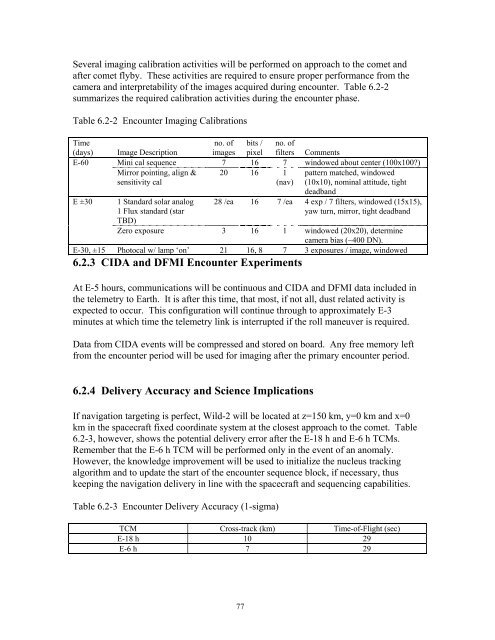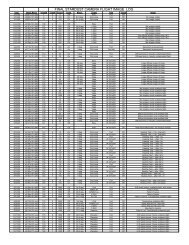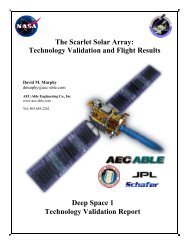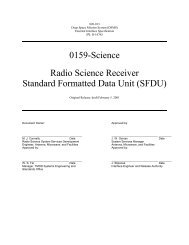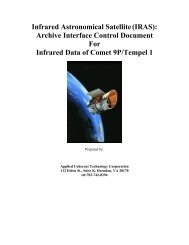MISSION PLAN - PDS Small Bodies Node
MISSION PLAN - PDS Small Bodies Node
MISSION PLAN - PDS Small Bodies Node
You also want an ePaper? Increase the reach of your titles
YUMPU automatically turns print PDFs into web optimized ePapers that Google loves.
Several imaging calibration activities will be performed on approach to the comet and<br />
after comet flyby. These activities are required to ensure proper performance from the<br />
camera and interpretability of the images acquired during encounter. Table 6.2-2<br />
summarizes the required calibration activities during the encounter phase.<br />
Table 6.2-2 Encounter Imaging Calibrations<br />
Time<br />
(days) Image Description<br />
no. of<br />
images<br />
bits /<br />
pixel<br />
no. of<br />
filters Comments<br />
E-60 Mini cal sequence 7 16 7 windowed about center (100x100?)<br />
Mirror pointing, align &<br />
sensitivity cal<br />
20 16 1<br />
(nav)<br />
pattern matched, windowed<br />
(10x10), nominal attitude, tight<br />
deadband<br />
E ±30<br />
1 Standard solar analog<br />
1 Flux standard (star<br />
TBD)<br />
28 /ea 16 7 /ea 4 exp / 7 filters, windowed (15x15),<br />
yaw turn, mirror, tight deadband<br />
Zero exposure 3 16 1 windowed (20x20), determine<br />
camera bias (~400 DN).<br />
E-30, ±15 Photocal w/ lamp ‘on’ 21 16, 8 7 3 exposures / image, windowed<br />
6.2.3 CIDA and DFMI Encounter Experiments<br />
At E-5 hours, communications will be continuous and CIDA and DFMI data included in<br />
the telemetry to Earth. It is after this time, that most, if not all, dust related activity is<br />
expected to occur. This configuration will continue through to approximately E-3<br />
minutes at which time the telemetry link is interrupted if the roll maneuver is required.<br />
Data from CIDA events will be compressed and stored on board. Any free memory left<br />
from the encounter period will be used for imaging after the primary encounter period.<br />
6.2.4 Delivery Accuracy and Science Implications<br />
If navigation targeting is perfect, Wild-2 will be located at z=150 km, y=0 km and x=0<br />
km in the spacecraft fixed coordinate system at the closest approach to the comet. Table<br />
6.2-3, however, shows the potential delivery error after the E-18 h and E-6 h TCMs.<br />
Remember that the E-6 h TCM will be performed only in the event of an anomaly.<br />
However, the knowledge improvement will be used to initialize the nucleus tracking<br />
algorithm and to update the start of the encounter sequence block, if necessary, thus<br />
keeping the navigation delivery in line with the spacecraft and sequencing capabilities.<br />
Table 6.2-3 Encounter Delivery Accuracy (1-sigma)<br />
TCM Cross-track (km) Time-of-Flight (sec)<br />
E-18 h 10 29<br />
E-6 h 7 29<br />
77


